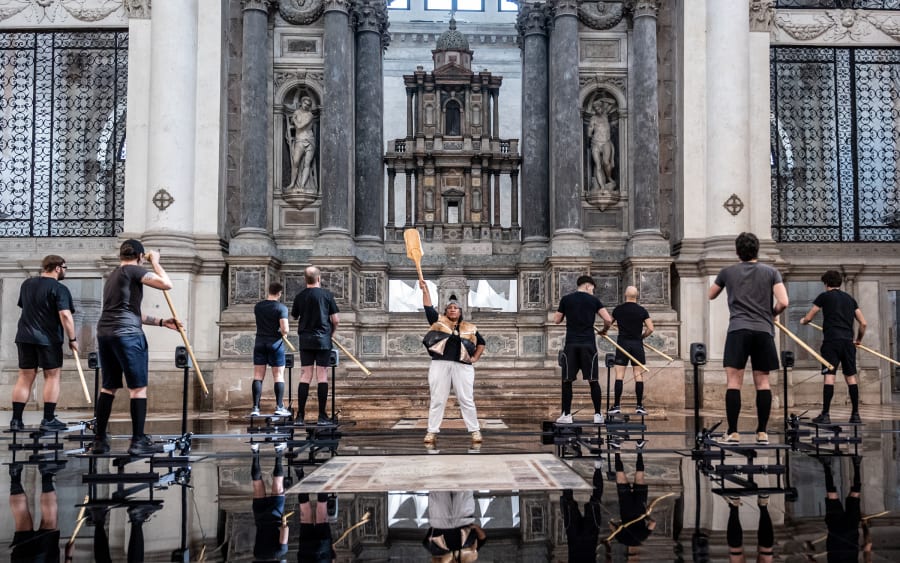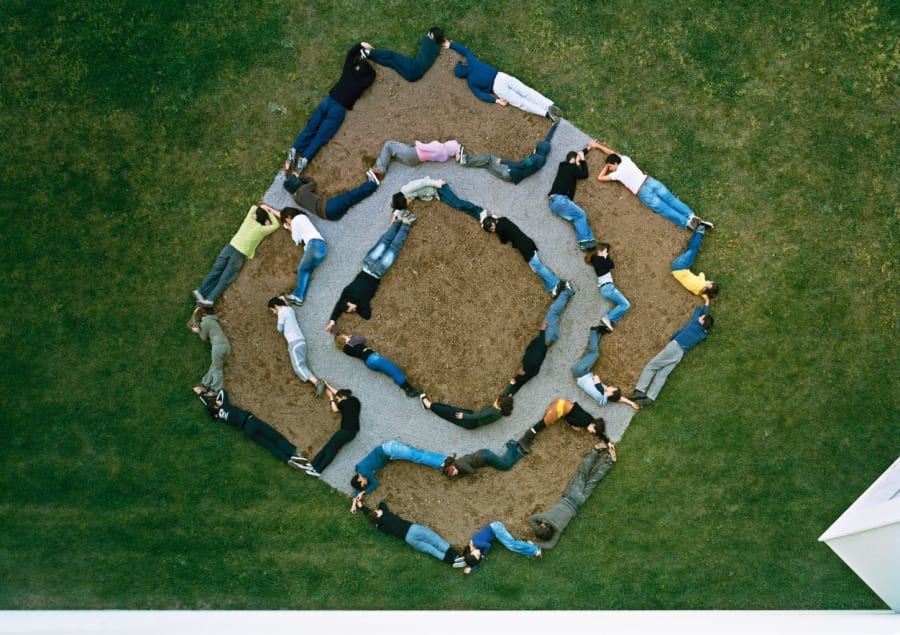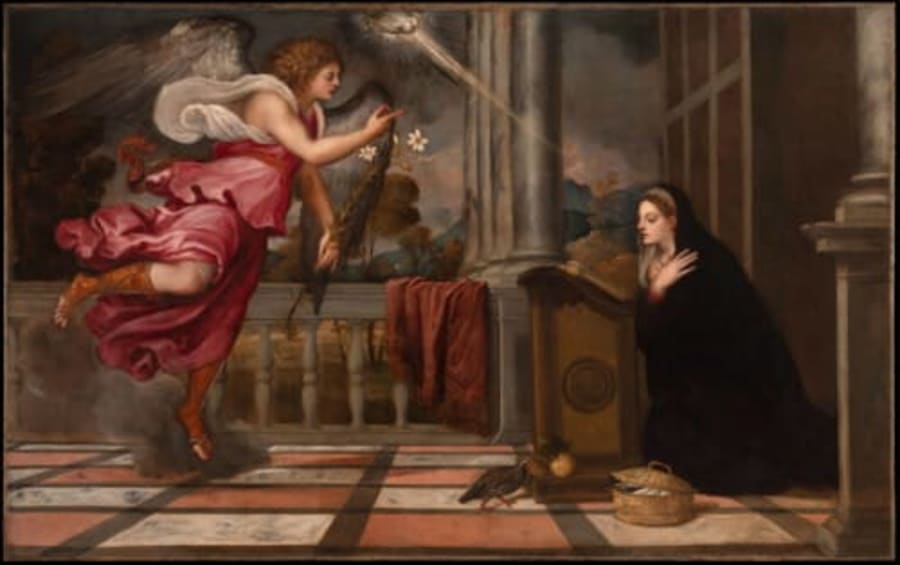Tradition versus innovation. Authenticity versus stereotype. Pride versus pain. To be a Native artist in today’s contemporary landscape is to constantly juggle centuries-old tensions, frequently echoed within the history of one’s chosen artistic medium. ‘The visual aesthetics of Indigenous communities are innately tied to alternative media that have often fallen into the category of “craft,”’ says John P. Lukavic, Andrew W. Mellon Curator of Native Arts at the Denver Art Museum, one of the first American institutions to collect Indigenous arts.
For centuries, ‘Indigenous people have expressed many aspects of themselves through regalia, beadwork, embroidery patterns, animal skins, and feathers that also express family ties or clans, life accomplishments and spiritual beliefs,’ says Kent Monkman, a Canadian First Nations artist of Cree ancestry. The interdisciplinarian is known for his charged paintings critiquing colonization, as well as his performances as his gender-fluid alter-ego, Miss Chief Eagle Testickle. ‘Art was not separate from other aspects of life, so creativity was and still is expressed through clothing and the creation of ceremonial and everyday objects.’
However, because Indigenous artists weren’t working with canvas, marble, bronze, or other materials ‘tied to Eurocentric art history,’ says Lukavic, ‘these media were not viewed as the same. But just because art is on one substrate versus another, that shouldn’t matter.’
As Jeffrey Gibson becomes the first Indigenous artist to have a solo presentation in the US Pavilion at the Venice Biennale this month, the art world is thankfully making strides. ‘There has been a huge shift in the field to look at artists who are engaging in fiber arts,’ says Lukavic, who curated the 2018 show ‘Jeffrey Gibson: Like a Hammer.’ ‘As you open more spaces to BIPOC artists, you’re inevitably opening spaces to a broader definition of what is considered to be ‘fine art,’” adds the curator.
Stateside, fourth-generation Navajo/Diné weaver Melissa Cody is also having a milestone month. More than 30 of her large-scale weavings are being exhibited in her first major solo museum presentation, ‘Melissa Cody: Webbed Skies.’ The show is organized by Museu de Arte de São Paulo Assis Chateaubriand and MoMA PS1, where it will be on view until September 9. Elsewhere, the artist, born in No Water Mesa, Arizona, and based in Long Beach, California, concurrently has a solo exhibition at New York’s Garth Greenan Gallery, as well as works in group shows at the Rhode Island School of Design Museum and the North Carolina Museum of Art. Cody’s road to success, however, has not been without its challenges.
‘Being put under this umbrella of “Native American art” is an added layer of boundary-breaking that we must do, not only to be considered craftspeople, but also to be considered fine artists,’ she says. Having grown up in the post-Assimilation Era – the period between 1887 and 1934, when the US government enacted several policies, such as forced boarding schools, to effectively eradicate Indigenous culture – Cody experiences another tension many fellow Indigenous artists must navigate: honoring and preserving what has been lost, while reinvigorating the fiber arts for present and future generations. ‘I’ve had to angle myself in multifaceted ways to elevate craft and, at the same time, hold true to the handmade quality of Navajo textiles and the medium’s cultural significance,’ says Cody, who hopes ‘to open doors’ for up-and-coming artists. She frequently teaches weaving workshops for both Native and non-Native hobbyists and aspiring artists of all ages. ‘I want them to have validation and to harness that voice to create work that’s going to be considered traditional 50 or 100 years from now.’
An antidote to the ‘textbook’ perception of ‘the old grandmother weaving a blanket outside in the desert sun,’ Cody aims to create ‘something that’s exciting and speaks to an individual story as opposed to weaving cookie-cutter template textiles.’ For example, she occasionally integrates personal or tongue-in-cheek phrases, such as ‘I am Navajo Barbie,’ into her designs, and opts for Technicolor hues over more traditional, muted ones.
Cody’s preferred ‘Germantown palette’ comes with a very dark past, which is equally important to her work. The Germantown Revival movement emerged after the Long Walk (1863–68), a devastating period in which the US military forced more than 10,000 Native American people to leave their territories and migrate to a military camp. During this time, the government supplied rationed wool and blankets, made in Germantown, Pennsylvania, to Navajo women, who would unravel the saturated, commercially dyed yarns and weave them in their own styles. ‘Even in this really dire time of us being on the brink of extermination, there was still a creative energy,’ says Cody. ‘This was a lifeline in terms of our survival.’
In that same spirit of reinvention, Cody is always looking to push her weaving forward. She has recently been experimenting with the Jacquard machine loom, which allows for more intricate patterning and texture, with about 1,200 colors available as opposed to 125 on a traditional Navajo loom. Expanding on her handwork, Cody enjoys revisiting past compositions and reconfiguring them in ways a Navajo loom wouldn’t allow. ‘The possibilities are seemingly endless.’
One of the reasons Gibson’s and Cody’s works feel so fresh and distinctive is their personal nods to their childhood preoccupations. Gibson frequently titles his works after songs he listened to growing up in the US, UK, Germany, and South Korea, while Cody often references ‘the world of pixelation’ she encountered playing video games. High fashion, too, has proven to be inspirational – Gibson cites as influences both the commanding designs of Alexander McQueen and the over-the-top looks of performance artist, designer, and queer icon, Leigh Bowery.
Jamie Okuma – who is of Shoshone-Bannock, Wailaki, and Okinawan heritage, as well as being an enrolled member of the La Jolla band of Luiseño Indians in Southern California – has achieved great success as both a fashion designer and a visual artist. Having begun her career making traditional powwow attire, Okuma’s design skills have translated into wholly original wearable garments and fine art objects. Among her most recognizable works are showstopping designer heels and boots, which she fully adorns in pictorial beadwork with leather, quills, feathers, and other embellishments.
When the Denver Art Museum gave Okuma carte blanche for a special commission in 2018, the artist produced a two-figure sculpture: an older woman wearing a ‘traditional’ hide dress and a younger one donning a miniature version of Okuma’s ‘couture ribbon dresses’ paired with her signature beaded, knee-high boots. ‘People have a stereotype in their minds of what an Indigenous person should look like,’ notes Lukavic. ‘Yet, the granddaughter figure is equally as Indigenous as the grandmother. She just expresses her Indigeneity through high fashion.’
Societal expectations for Indigenous dress, especially pan-Native stereotypes, have also been a major influence on Monkman’s practice. ‘Earlier in his career, he leaned into camp and humor to intentionally make very challenging subject matters more approachable,’ explains Lukavic. Objects poked at appropriation of Native symbols and clichés: for example, a Louis Vuitton quiver, dreamcatcher bra, and raccoon jockstrap. ‘I claim some of these tropes to comment on their meaninglessness as mass-produced tourist gifts or novelty items that simply have no significance as Indigenous cultural objects,’ says Monkman. ‘One cannot reclaim something that is already completely fake. Reducing Indigenous people to cartoon characters removes any nuance or cultural difference amongst the hundreds of varied and complex communities and linguistic groups throughout the Americas,’ he adds.
Over the last decade, Lukavic tells me, Monkman’s work has put humor aside in favor of ‘a very direct confrontation and engagement with subjects that are important to contemporary Indigenous people,’ such as generational trauma, urbanization, language loss, and LGBTQ+ representation. ‘At the same time, he’s intentionally “decolonizing sexuality,” as he describes it. It’s about showing the nude human form as normal – not something that has to be sexualized – as well as showing different body types and gender expressions as normal, to counter the imposed, puritanical Christian viewpoints that were never what most Indigenous communities believed.’
Occasionally, Monkman’s alter-ego, Miss Chief, makes an appearance on canvas. In the early 2000s, the artist conceived this time-traveling, shape-shifting performance persona to reflect the Indigenous ‘two-spirit’ tradition, which reveres a third gender and nonbinary sexuality, subverting colonial constructions of masculinity. Feathered headdresses, thigh-high boots, satin gloves, and sequined gowns typically comprise Miss Chief’s attire, though one of her most memorable ensembles is a dress resembling a tipi.
‘With the clothing for my performances, I respond to the reductive views held by settler artists who believed that Indigenous people didn’t exist unless they dressed exactly as they did before contact,’ says Monkman, noting Miss Chief’s first-ever outfit was inspired by Bob Mackie’s controversial stage costume for Cher’s 1973 song ‘Half-Breed’ ‘to comment on the pop star’s cultural and gender cross-dressing.’
Whether it’s through innovating a centuries-old practice or turning a centuries-old stereotype on its head, Indigenous artists today are brilliantly demonstrating the breadth and power of more nuanced, intergenerational perspectives and cultural expressions. The potency of dress and textiles as vehicles for storytelling across their multifaceted oeuvres makes an undeniable case for fiber art as fine art – for each thread reconciles the past with the present.
Stephanie Sporn is a New York-based author, specialized in the intersection between art and fashion.
Caption for top image: Melissa Cody, Dopamine Dream, 2023. Courtesy of the artist and Garth Greenan Gallery, New York.
Published on April 24, 2024.


